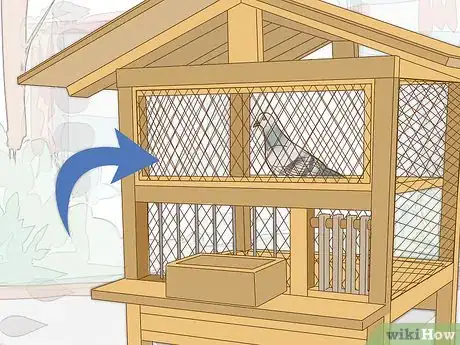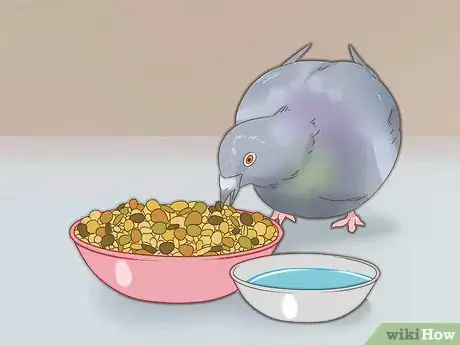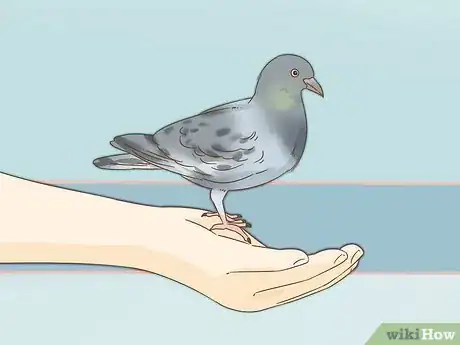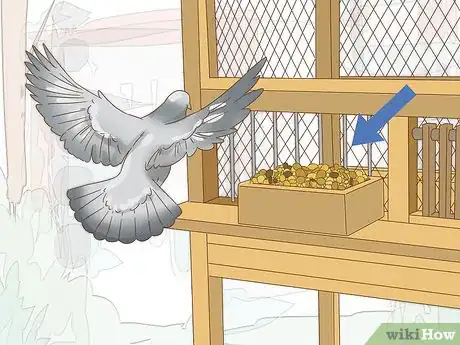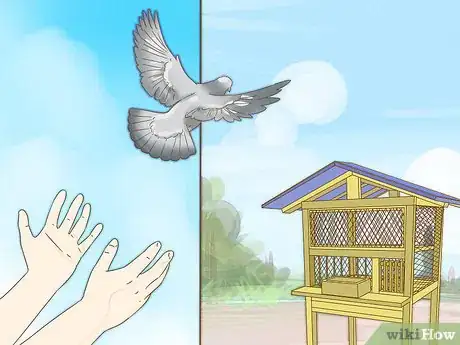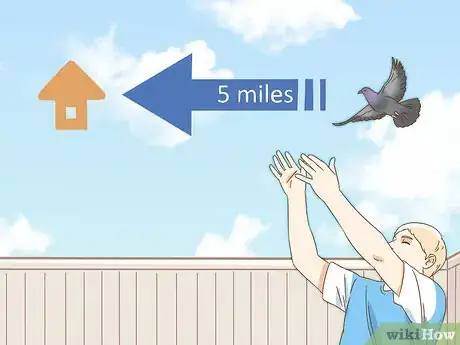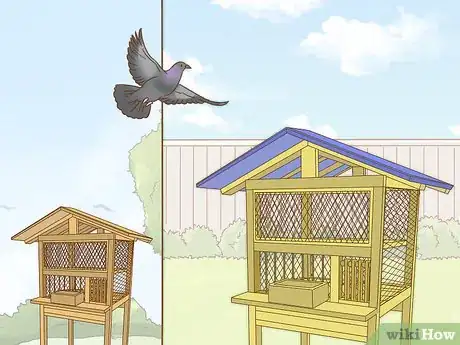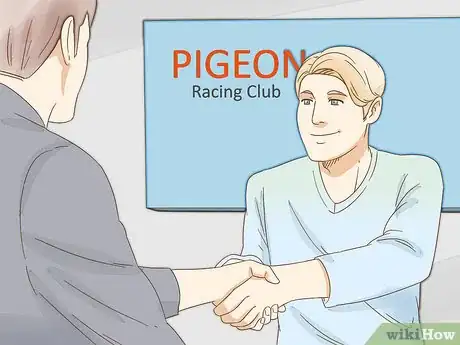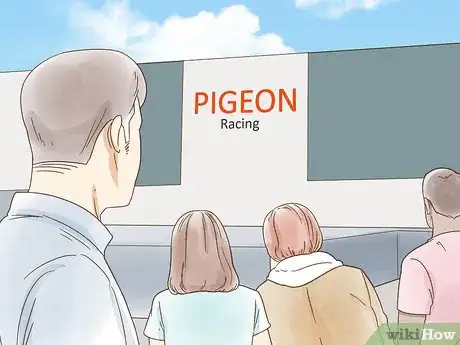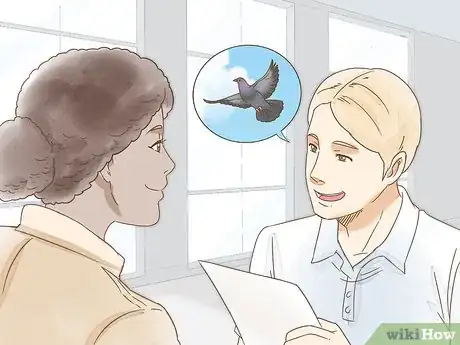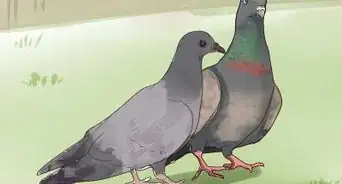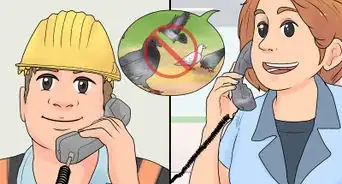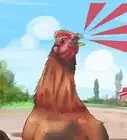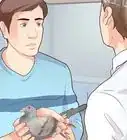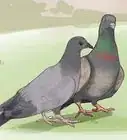This article was co-authored by Pippa Elliott, MRCVS. Dr. Elliott, BVMS, MRCVS is a veterinarian with over 30 years of experience in veterinary surgery and companion animal practice. She graduated from the University of Glasgow in 1987 with a degree in veterinary medicine and surgery. She has worked at the same animal clinic in her hometown for over 20 years.
There are 18 references cited in this article, which can be found at the bottom of the page.
wikiHow marks an article as reader-approved once it receives enough positive feedback. This article received 15 testimonials and 89% of readers who voted found it helpful, earning it our reader-approved status.
This article has been viewed 573,809 times.
Homing pigeons (Columbia livia) are also known as rock pigeons or sometimes rock doves. Most rock pigeons are found in large cities, usually eating scraps of food off the sidewalk. Rock pigeons are not native to North America and were introduced by Europeans in the 1600s. Rock pigeons have an amazing history - domesticated over 5,000 years ago, they were used to carry messages from one place to another, as they have an innate ability to find their way home. They were even used in World Wars I and II to send messages between members of the U.S. Army. People continue to train rock pigeons today to carry messages and race.[1]
Steps
Selecting and Caring for a Homing (Rock) Pigeon
-
1Decide how much you’re willing to spend. You should purchase the highest quality birds that you can afford. It is better to purchase a smaller number of pairs of a higher quality, than a larger number of pairs of a lower quality. You should buy pigeons in pairs, unless you’re buying a very specific pigeon of a particular pedigree.
- If you’re buying the pigeons for the purpose of racing, base your buying decision on performance before anything else. This can include the performance of the specific pigeons you’re purchasing, the performance of the family line (i.e pedigree), or even the performance of the breed.[2]
- If you’re buying the pigeons for show purposes, or you just want really cool looking pigeons, then you’ll want to base your buying decision on conformation. For show purposes, judges pick winning pigeons based on a certain list of physical characteristics.[3]
- Homing pigeons can cost anywhere from approximately $50 up to several hundred dollars, depending on the pedigree and breeder.
- Keep in mind that in addition to the cost of the pigeons, you must also pay the cost of shipping. And because you’re shipping live animals, shipping can be quite expensive, depending on where you’re ordering from.[4]
-
2Build a home for your pigeons before they arrive. Your pigeons are going to need a place to live the minute they arrive at your door, so be prepared. Pigeon homes are referred to as lofts and lofts can come in a variety of sizes and configurations. You can build your own, hire someone to build one for your, or order one pre-made. Each pair of pigeons should have approximately 8-10 cubic feet of space inside the loft - so the space you have available for a loft might also dictate the maximum number of pigeons you can have.[5]
- Some of the most important things to remember about a loft is that it should: protect your pigeons from predators (including the neighbourhood cat), have both interior and exterior (protected) space for the birds, have an excellent ventilation system, and have additional space for feed and equipment (you don’t want to store this stuff outside). If you’re breeding your pigeons, you will also need to separate out a space just for them and their eventual offspring.[6]
- Pigeon lofts need to be located in an area somewhat free of aerial obstructions. Remember, your pigeons fly, so wires, trees, lamp posts, etc., can be a distraction for your pigeons when you’re trying to train them.[7]
- Racing pigeon lofts should be designed so the birds don’t spend a lot of time on the roof. This means the roof should not be flat, if possible, and might need bird spikes to help deter your pigeons from landing.[8]
Advertisement -
3Locate a breeder or seller and order your pigeons. Pigeon breeders and sellers are located around the world. If you’re concerned about the cost of shipping your pigeons, you’ll probably want to choose a breeder located as close to you as possible. Otherwise you’ll want to choose a breeder based on pigeon performance and pedigree.[9] [10]
- Most breeders band their pigeons when they’re young, so this is not something you’ll have to do once you receive your pigeon.[11]
- Ask for recommendations from a local pigeon club if you’re unsure as to the reputation of a breeder.
-
4Introduce your pigeons to their new home. If these are your first pigeons, then you can put them in the loft right away without a problem. However, if you’re adding new pigeons to your collection, you’ll need to keep them separated from your existing pigeons for a couple of weeks.[12]
-
5Take good care of your pigeons. Your pigeons need clean water everyday. Their food should be consumed within 15-20 minutes of you giving it to them. After 15-20 minutes cleanup and remove anything they haven’t eaten. They’ll also need grit to ingest, which helps them obtain vitamin and minerals, and assists with digestion.[13] You’ll need to feed your pigeons (using the 15-20 minute technique) twice per day.
- Remember to clean your loft on a regular basis, especially the floor.
- There are several bird-specific online stores located around the United States that specialize in pigeon care. Their level of experience will be helpful if you’re new to the world of pigeons.
- Pigeons will require more protein if they’re breeding, but more energy (i.e. fat and carbohydrates) when they are racing. The protein amounts contained in the feed should be listed on the bag. For breeding season you should feed them a 16-18% crude protein mix. For racing and training season you should feed them a 14-15% crude protein mix. When you pigeons are molting, in the off season, you’ll want to feed them the 16% crude protein mix again.
- While all veterinarians have learned to care for birds as part of their training, not all veterinarians will take care of birds on a regular basis. If you already have a vet whom you trust, and they feel confident they can treat your pigeons, great. If not, ask for recommendations or referrals to a bird-specific vet in your area. You can also ask for referrals from a local pigeon racing club, or pigeon rescue organization.
Training a Homing (Rock) Pigeon
-
1Start your pigeons’ training program when they’re 6 weeks old. At 6 weeks you can help your pigeons figure out the trapdoor in your pigeon loft. The trapdoor is designed to allow your pigeons to get into the loft anytime they want, but you’ll be able to set the trapdoor to only let them out when you want.[14] These trapdoors might be a little confusing to your pigeons at first, so you might have to help them go in and out at first.[15]
- It may be helpful to put together a training schedule so you have something specific to follow everyday. Training requires dedication on your part, so knowing what you have to be ready for each day will help keep the training consistent. The training schedule should allow for training to occur at least once a day, and either the method or distance being worked on should change once a week. For example: everyday during week 1 practice going in and out of the trap door with the pigeon; everyday during week 2 practice returning to the loft from 1 mile away; etc.
- Read pigeon club blogs - specifically ones written from your geographical area. Local blogs will have advice on your specific geography and climate.
-
2Ensure your pigeons have incentive to return to their loft. Good food, comfortable lodgings and being treated like royalty is what makes your pigeons want to come back. Provide your pigeons with the highest quality food and lodgings you can afford.
-
3Begin training your pigeons to come home after being released. This part of the training can begin when your pigeons are between 6 and 8 weeks old.[16] Start by taking your pigeons 1 mile from home and releasing them. Do this several times a week.[17]
- Use a cage or a basket to carry your pigeons to the release location.
-
4Expand the training distance by 5 miles per week. Each week go further away from home to release your pigeons[18] , and go in different directions each time.[19]
- Don’t expand the distance too far, too fast. If your pigeons have any trouble, stop increasing the distance and continue training them at the last distance they were successful.
- Some of the longest pigeon races are several hundred miles in a single flight. This is the maximum distance from home that you should practice with your pigeon, but do not go to these distances until your pigeon is able to return from shorter distances, in any direction, consistently.
-
5Be careful of bird loss. Bird loss is unfortunate, but not uncommon. If you experience bird loss, reduce the training distance and frequency for a while.[20] For example, if you were training at the 10 mile distance, reduce back to 5 miles for several weeks.
- Pigeon clubs all have lost bird reporting processes that you can take advantage of if you lose a bird. People who find lost birds can report those birds (using their leg bands) on these websites. You can then contact the finder and arrange to have your bird brought home.
- Some pigeons might simply get tired on their return journey and need time to rest. While they may normally come back to the loft in one day, it may take them a few days to return if they've stopped for a break.
-
6Create a second “home” for your pigeons. In addition to training your pigeons to return to your home loft, you can train them to fly between two loft locations (maybe your home and your cottage, or your home and a friend’s home, etc.). Feed your pigeons at both lofts periodically, to give them incentive to want to return to each loft. If they’re at one loft and are hungry, they’ll fly to the other loft to look for food.[21]
Racing a Homing (Rock) Pigeon
-
1Find a local pigeon racing club and join. The American Racing Pigeon Union (ARPU) is the national organization for pigeon racing. They have hundreds of affiliated clubs around the United States. Most homing pigeons, when purchased from an American breeder, will come banded with an ARPU band. Use the ARPU’s “Find a Club” link on their website to locate the nearest club to you.[22]
- The ARPU has a number of different memberships available, including junior memberships (for kids under 18), family memberships, and memberships for people interested in pigeon racing, but unable to participate.[23] You will have to be an active member of the ARPU before you can join a local club.
-
2Attend racing events and observe. Using your local club’s website, Facebook page, or newsletter, you can determine when that club will be hosting races throughout the year. Races are normally divided between “young birds” and “old birds”.
- You may also want to consider attending the American Racing Pigeon Union’s annual convention, if you have the time and funds. The ARPU’s convention is held in a different location each year.[24] The convention usually includes a race.
-
3Get advice from existing pigeon racers. The ARPU offers a “Help-a-Beginner” Program which is for those who have only flown in one racing season and would like some assistance or advice on how to be a better pigeon racer. Beginners are matched with mentors and breeders and work together throughout the season.[25]
-
4Enter your pigeons in racing events. Once you’re a member of a local club, you’ll be able to enter your pigeons in races. Check with your club to determine the best race for beginners - which would usually be a shorter race. Try racing different pigeons in different races to see how they perform.
- Note that the “Help-a-Beginner” program doesn’t allow beginners who have raced more than one season to participate. Therefore, if you’re interested in this program make sure to apply after your first racing season.[26]
-
5Race your pigeons. Pigeons race from a specific location (as determined by the race organizers) to their home loft (i.e. your house). The organization will determine the actual distance between the release point and your home loft, and that distance, plus the time the pigeon took to travel, will be used to calculate speed.[27] And the fastest pigeon wins!
Expert Q&A
Did you know you can get expert answers for this article?
Unlock expert answers by supporting wikiHow
-
QuestionHow can I train my homing pigeon to fly for a long time?
 Pippa Elliott, MRCVSDr. Elliott, BVMS, MRCVS is a veterinarian with over 30 years of experience in veterinary surgery and companion animal practice. She graduated from the University of Glasgow in 1987 with a degree in veterinary medicine and surgery. She has worked at the same animal clinic in her hometown for over 20 years.
Pippa Elliott, MRCVSDr. Elliott, BVMS, MRCVS is a veterinarian with over 30 years of experience in veterinary surgery and companion animal practice. She graduated from the University of Glasgow in 1987 with a degree in veterinary medicine and surgery. She has worked at the same animal clinic in her hometown for over 20 years.
Veterinarian It is more the distance rather than the time that is important. To fly long distances, first make sure the bird sees their loft as base or home. Then transport the bird a short distance, say half a mile, in a travel box and release her. She should fly back home. By gradually extending the distance you take her away from the loft, you can teach her to fly further and for longer.
It is more the distance rather than the time that is important. To fly long distances, first make sure the bird sees their loft as base or home. Then transport the bird a short distance, say half a mile, in a travel box and release her. She should fly back home. By gradually extending the distance you take her away from the loft, you can teach her to fly further and for longer. -
QuestionHow do you train your pigeon to send letters and go to the right place?
 Pippa Elliott, MRCVSDr. Elliott, BVMS, MRCVS is a veterinarian with over 30 years of experience in veterinary surgery and companion animal practice. She graduated from the University of Glasgow in 1987 with a degree in veterinary medicine and surgery. She has worked at the same animal clinic in her hometown for over 20 years.
Pippa Elliott, MRCVSDr. Elliott, BVMS, MRCVS is a veterinarian with over 30 years of experience in veterinary surgery and companion animal practice. She graduated from the University of Glasgow in 1987 with a degree in veterinary medicine and surgery. She has worked at the same animal clinic in her hometown for over 20 years.
Veterinarian This is about teaching the bird to fly between two places. The loft is her base and she should be used to returning here. Decide on the second location, take her there, feed her and then release her. Repeat this several times. When you want to send a message with her, remove the food from her home loft and release her. She should fly to the second base that she associates with food. Attach the message to a special lightweight pigeon backpack.
This is about teaching the bird to fly between two places. The loft is her base and she should be used to returning here. Decide on the second location, take her there, feed her and then release her. Repeat this several times. When you want to send a message with her, remove the food from her home loft and release her. She should fly to the second base that she associates with food. Attach the message to a special lightweight pigeon backpack.
Warnings
- Before buying a homing (rock) pigeon and building a loft for it in your backyard or on your roof, check your local bylaws for any restrictions on the types of pets allowed within city limits.⧼thumbs_response⧽
- If you buy your pigeon feed through a farm supply store, make sure you’re buying feed grain and not seed grain. Seed grain is designed for planting crops and contains chemicals that can be harmful to animals. Feed grain, while more expensive, is designed specifically for animal consumption.⧼thumbs_response⧽
References
- ↑ http://www.allaboutbirds.org/guide/Rock_Pigeon/lifehistory
- ↑ http://www.barnhartlofts.com/value.htm
- ↑ http://www.barnhartlofts.com/value.htm
- ↑ http://www.strombergschickens.com/shipping
- ↑ http://www.strombergschickens.com/general_pigeon_information
- ↑ http://www.strombergschickens.com/general_pigeon_information
- ↑ http://www.pigeonweb.net/pigeon-lofts
- ↑ http://raisinghomingpigeons.com/racing-pigeon-lofts/
- ↑ http://www.barnhartlofts.com/salebirds.htm
- ↑ http://www.pigeonfarms.com/pigeon-price-table/
- ↑ http://www.strombergschickens.com/general_pigeon_information
- ↑ http://www.strombergschickens.com/general_pigeon_information
- ↑ http://www.strombergschickens.com/general_pigeon_information
- ↑ http://animals.mom.me/train-homing-pigeon-carry-message-10844.html
- ↑ https://sites.google.com/site/awdahomepage/Home/white-doves-and-white-homing-pigeons-or-white-homers
- ↑ https://sites.google.com/site/awdahomepage/Home/white-doves-and-white-homing-pigeons-or-white-homers
- ↑ https://sites.google.com/site/awdahomepage/Home/white-doves-and-white-homing-pigeons-or-white-homers
- ↑ http://animals.mom.me/train-homing-pigeon-carry-message-10844.html
- ↑ https://sites.google.com/site/awdahomepage/Home/white-doves-and-white-homing-pigeons-or-white-homers
- ↑ https://sites.google.com/site/awdahomepage/Home/white-doves-and-white-homing-pigeons-or-white-homers
- ↑ http://animals.mom.me/train-homing-pigeon-carry-message-10844.html
- ↑ http://www.pigeon.org/findaclub.php
- ↑ http://www.pigeon.org/membershipstore.htm
- ↑ http://www.pigeon.org
- ↑ http://www.pigeon.org/beginnerscorner.htm
- ↑ http://www.pigeon.org/beginnerscorner.htm
- ↑ http://www.fbipigeons.com/THE%20SPORT.htm
- ↑ https://www.audubon.org/magazine/may-june-2014/why-passenger-pigeon-went-extinct
- ↑ http://www.animalbehavioronline.com/pigeonhoming.html
- ↑ http://www.ncbi.nlm.nih.gov/pubmed/9317262
About This Article
To train a homing pigeon, you should purchase the highest pedigree rock pigeon that you can afford. Ask around at your local pigeon club for recommendations on breeders. Once your birds arrive, make sure they have a nice home and plenty of food that they will want to return to each day. Start training your pigeons at 6-8 weeks old by dropping them off away from your house and rewarding them with food when they return home. Gradually, increase the distance until they fly home from 5-10 miles away. For tips from our Veterinary reviewer on what to do if your bird gets lost, keep reading.



